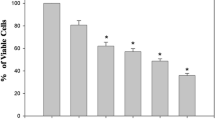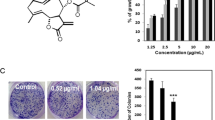Abstract
The antiproliferative effect of cardamonin on mTORC1 is related with downregulation of Raptor. We investigated the mechanism that cardamonin decreases Raptor expression through caspase-mediated protein degradation. SKOV3 cells and HeLa cells were pretreated with caspase inhibitor z-VAD-fmk for 30 min and then exposed to different doses of cardamonin and cisplatin, respectively. We analyzed the gene expression of caspases based on TCGA and GTEx gene expression data in serous cystadenocarcinoma and normal tissues, monitored caspase activity by caspase colorimetric assay kit, detected expression of mTORC1-associated proteins and apoptosis-associated proteins by western blotting, and finally detected cell viability by methyl thiazolyl tetrazolium (MTT) assay. A different expression of caspases except caspase-1 was found between serous cystadenocarcinoma and normal tissues. Raptor was cleaved when caspases were activated by cisplatin and caspase-6/caspase-8 was activated by cardamonin in SKOV3 cells. We further used a monoclonal antibody recognizing the N-terminal part of Raptor to find that Raptor was cleaved into a smaller fragment of about 70 kDa by cardamonin and was rescued by z-VAD-fmk treatment. As a result of Raptor cleavage, mTORC1 activity was decreased and cell viability was inhibited, while cell apoptosis was induced in SKOV3 cells. Notably, similar results are only observed in HeLa cells with a high dose of cardamonin. We concluded that caspase-mediated cleavage of Raptor might be an important mechanism in that cardamonin regulated Raptor and mTORC1 activity.







Similar content being viewed by others
References
Chen J et al (2016) Gankyrin facilitates follicle-stimulating hormone-driven ovarian cancer cell proliferation through the PI3K/AKT/HIF-1alpha/cyclin D1 pathway. Oncogene 35:2506–2517. https://doi.org/10.1038/onc.2015.316
Elia A et al (2017) Implication of 4E-BP1 protein dephosphorylation and accumulation in pancreatic cancer cell death induced by combined gemcitabine and TRAIL. Cell Death Dis 8:3204–3214. https://doi.org/10.1038/s41419-017-0001-z
Gasparri ML et al (2017) PI3K/AKT/mTOR pathway in ovarian cancer treatment: are we on the right track? Geburtshilfe Frauenheilkd 77:1095–1103. https://doi.org/10.1055/s-0043-118907
Ginalski K, Zhang H, Grishin NV (2004) Raptor protein contains a caspase-like domain. Trends Biochem Sci 29:522–524. https://doi.org/10.1016/j.tibs.2004.08.006
Goncalves LM, Valente IM, Rodrigues JA (2014) An overview on cardamonin. J Med Food 17:633–640. https://doi.org/10.1089/jmf.2013.0061
Gray DC, Mahrus S, Wells JA (2010) Activation of specific apoptotic caspases with an engineered small-molecule-activated protease. Cell 142:637–646. https://doi.org/10.1016/j.cell.2010.07.014
Hodson N et al (2017) Differential localization and anabolic responsiveness of mTOR complexes in human skeletal muscle in response to feeding and exercise. Am J Phys Cell Phys 313:C604–C611. https://doi.org/10.1152/ajpcell.00176.2017
Hou S, Yuan Q, Yu N, Liu B, Huang G, Yuan X (2019) Cardamonin attenuates chronic inflammation and tumorigenesis in colon. Cell Cycle 18:3275–3287. https://doi.org/10.1080/15384101.2019.1673620
Jin J, Qiu S, Wang P, Liang X, Huang F, Wu H, Zhang B, Zhang W, Tian X, Xu R, Shi H, Wu X (2019) Cardamonin inhibits breast cancer growth by repressing HIF-1alpha-dependent metabolic reprogramming. J Exp Clin Cancer Res 38:377–392. https://doi.org/10.1186/s13046-019-1351-4
Kakiuchi Y et al (2019) Pharmacological inhibition of mTORC1 but not mTORC2 protects against human disc cellular apoptosis, senescence, and extracellular matrix catabolism through Akt and autophagy induction. Osteoarthr Cartil 27:965–976. https://doi.org/10.1016/j.joca.2019.01.009
Kim DH et al (2002) mTOR interacts with raptor to form a nutrient-sensitive complex that signals to the cell growth machinery. Cell 110:163–175. https://doi.org/10.1016/s0092-8674(02)00808-5
Laplante M, Sabatini DM (2012) mTOR signaling in growth control and disease. Cell 149:274–293. https://doi.org/10.1016/j.cell.2012.03.017
Liao Q, Shi DH, Zheng W, Xu XJ, Yu YH (2010) Antiproliferation of cardamonin is involved in mTOR on aortic smooth muscle cells in high fructose-induced insulin resistance rats. Eur J Pharmacol 641:179–186. https://doi.org/10.1016/j.ejphar.2010.05.024
Liao NC et al (2019) Cardamonin induces cell cycle arrest, apoptosis and alters apoptosis associated gene expression in WEHI-3 mouse leukemia cells. Am J Chin Med 47:635–656. https://doi.org/10.1142/S0192415X19500332
Liemburg-Apers DC, Wagenaars JA, Smeitink JA, Willems PH, Koopman WJ (2016) Acute stimulation of glucose influx upon mitoenergetic dysfunction requires LKB1, AMPK, Sirt2 and mTOR-RAPTOR. J Cell Sci 129:4411–4423. https://doi.org/10.1242/jcs.194480
Martin R, Desponds C, Eren RO, Quadroni M, Thome M, Fasel N (2016) Caspase-mediated cleavage of raptor participates in the inactivation of mTORC1 during cell death. Cell Death Dis 2:16024–16034. https://doi.org/10.1038/cddiscovery.2016.24
Miller KD et al (2016) Cancer treatment and survivorship statistics, 2016 CA. Cancer J Clin 66:271–289. https://doi.org/10.3322/caac.21349
Mossmann D, Park S, Hall MN (2018) mTOR signalling and cellular metabolism are mutual determinants in cancer. Nat Rev Cancer 18:744–757. https://doi.org/10.1038/s41568-018-0074-8
Nie X et al (2020) DAP1 negatively regulates autophagy induced by cardamonin in SKOV3 cells cell biol Int doi:https://doi.org/10.1002/cbin.11425
Niu P, Zhang Y, Shi D, Chen Y, Deng J (2013) Cardamonin ameliorates insulin resistance induced by high insulin and high glucose through the mTOR and signal pathway. Planta Med 79:452–458. https://doi.org/10.1055/s-0032-1328325
Niu PG, Zhang YX, Shi DH, Liu Y, Chen YY, Deng J (2015) Cardamonin inhibits metastasis of Lewis lung carcinoma cells by decreasing mTOR activity. PLoS One 10:e0127778. https://doi.org/10.1371/journal.pone.0127778
Ozeki M et al (2019) Efficacy and safety of sirolimus treatment for intractable lymphatic anomalies: a study protocol for an open-label, single-arm, multicenter, prospective study (SILA). Regen Ther 10:84–91. https://doi.org/10.1016/j.reth.2018.12.001
Pascoal AC et al (2014) Antiproliferative activity and induction of apoptosis in PC-3 cells by the chalcone cardamonin from Campomanesia adamantium (Myrtaceae) in a bioactivity-guided study. Molecules 19:1843–1855. https://doi.org/10.3390/molecules19021843
Patel V, Balakrishnan K, Keating MJ, Wierda WG, Gandhi V (2015) Expression of executioner procaspases and their activation by a procaspase-activating compound in chronic lymphocytic leukemia cells. Blood 125:1126–1136. https://doi.org/10.1182/blood-2014-01-546796
Shen K, Valenstein ML, Gu X, Sabatini DM (2019) Arg-78 of Nprl2 catalyzes GATOR1-stimulated GTP hydrolysis by the rag GTPases. J Biol Chem 294:2970–2975. https://doi.org/10.1074/jbc.AC119.007382
Shi D, Niu P, Heng X, Chen L, Zhu Y, Zhou J (2018a) Autophagy induced by cardamonin is associated with mTORC1 inhibition in SKOV3 cells. Pharmacol Rep 70:908–916. https://doi.org/10.1016/j.pharep.2018.04.005
Shi D, Zhu Y, Niu P, Zhou J, Chen H (2018b) Raptor mediates the antiproliferation of cardamonin by mTORC1 inhibition in SKOV3 cells. Onco Targets Ther 11:757–767. https://doi.org/10.2147/OTT.S155065
Sohretoglu D, Zhang C, Luo J, Huang S (2019) ReishiMax inhibits mTORC1/2 by activating AMPK and inhibiting IGFR/PI3K/Rheb in tumor cells. Signal Transduct Target Ther 4:21–28. https://doi.org/10.1038/s41392-019-0056-7
Sun D et al (2017) Aspirin disrupts the mTOR-raptor complex and potentiates the anti-cancer activities of sorafenib via mTORC1 inhibition. Cancer Lett 406:105–115. https://doi.org/10.1016/j.canlet.2017.06.029
Tang Y, Fang Q, Shi D, Niu P, Chen Y, Deng J (2014) mTOR inhibition of cardamonin on antiproliferation of A549 cells is involved in a FKBP12 independent fashion. Life Sci 99:44–51. https://doi.org/10.1016/j.lfs.2014.01.066
Van Opdenbosch N, Lamkanfi M (2019) Caspases in cell death, inflammation, and disease immunity, vol 50, pp 1352–1364. https://doi.org/10.1016/j.immuni.2019.05.020
Wang XJ et al (2010) Crystal structures of human caspase 6 reveal a new mechanism for intramolecular cleavage self-activation. EMBO Rep 11:841–847. https://doi.org/10.1038/embor.2010.141
Yang H et al (2016) 4.4 A resolution cryo-EM structure of human. mTOR complex 1 protein cell 7:878–887. https://doi.org/10.1007/s13238-016-0346-6
Yao Y, Jones E, Inoki K (2017) Lysosomal regulation of mTORC1 by amino acids in mammalian cells. Biomolecules 7:51–68. https://doi.org/10.3390/biom7030051
Zhang H et al (2016) Integrated Proteogenomic Characterization of Human High-Grade Serous Ovarian Cancer. Cell 166:755–765. https://doi.org/10.1016/j.cell.2016.05.069
Zhang X et al (2019) Circular RNA circNRIP1 acts as a microRNA-149-5p sponge to promote gastric cancer progression via the AKT1/mTOR pathway. Mol Cancer 18:20–43. https://doi.org/10.1186/s12943-018-0935-5
Zheng W, Shi D, Ji X, Han Y, Liao Q (2010) Antiproliferation of cardamonin associated with mRNA expression of mTOR. Raptor and Rictor Zhongguo Zhong Yao Za Zhi 35:2318–2323
Zobeiri M, Momtaz S, Parvizi F, Tewari D, Farzaei MH, Nabavi SM (2019) Targeting mitogen-activated protein kinases by natural products: a novel therapeutic approach for inflammatory bowel diseases Curr pharm Biotechnol doi:https://doi.org/10.2174/1389201021666191216122555
Funding
This study was supported by the Natural Science Foundation of Fujian Province of China (2019 J01508), Fujian Provincial Health Technology Project (2017-1-18, 2017-1-19), and Foundations of Fujian Maternity and Child Health Hospital (YCXZ 18-07, YCXQ 18-02, YCXM 19-05), China.
Author information
Authors and Affiliations
Contributions
DS and YZ conceived and designed research. YZ and JZ conducted experiments. HC and PN analyzed data. YZ wrote the manuscript. All authors read and approved the manuscript. All data were generated in-house, and we did not use a paper mill.
Corresponding author
Ethics declarations
Conflict of interest
There are no conflicts of interest.
Additional information
Publisher’s note
Springer Nature remains neutral with regard to jurisdictional claims in published maps and institutional affiliations.
Rights and permissions
About this article
Cite this article
Zhu, Y., Zhou, J., Niu, P. et al. Cardamonin inhibits cell proliferation by caspase-mediated cleavage of Raptor. Naunyn-Schmiedeberg's Arch Pharmacol 394, 809–817 (2021). https://doi.org/10.1007/s00210-020-01986-z
Received:
Accepted:
Published:
Issue Date:
DOI: https://doi.org/10.1007/s00210-020-01986-z




